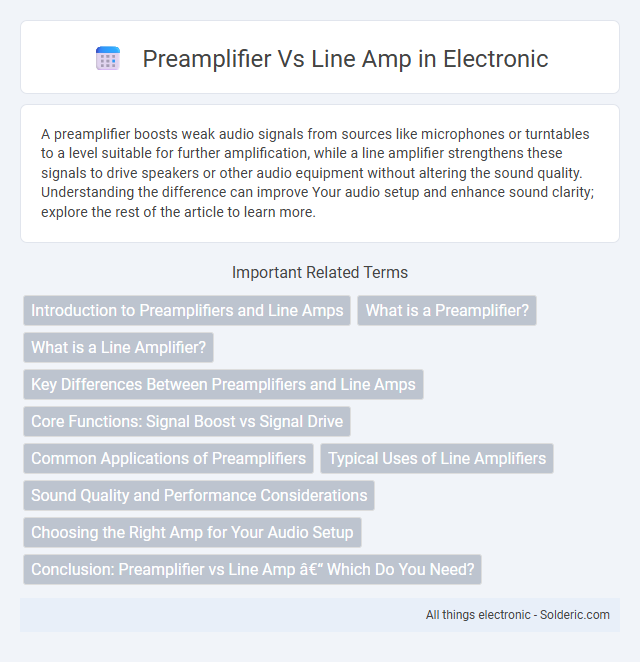A preamplifier boosts weak audio signals from sources like microphones or turntables to a level suitable for further amplification, while a line amplifier strengthens these signals to drive speakers or other audio equipment without altering the sound quality. Understanding the difference can improve Your audio setup and enhance sound clarity; explore the rest of the article to learn more.
Comparison Table
| Feature | Preamplifier | Line Amplifier |
|---|---|---|
| Primary Function | Amplifies weak audio signals to a usable level | Boosts line-level audio signals without adding gain stages |
| Signal Level | Mic or instrument level | Line level (typically +4 dBu or -10 dBV) |
| Gain Range | High gain (up to 60 dB or more) | Low to moderate gain (typically 10-20 dB) |
| Noise Handling | Designed to minimize noise and distortion | Usually transparent with low noise addition |
| Typical Use Case | Microphone or instrument input stage in audio devices | Signal level adjustment between equipment in audio chain |
| Output | Line-level signal | Line-level signal with adjusted amplitude |
| Complexity | More complex circuitry due to gain and noise control | Simpler design focusing on signal boosting |
Introduction to Preamplifiers and Line Amps
Preamplifiers boost weak audio signals from sources like microphones or instruments to a level suitable for further processing, preserving sound quality and detail. Line amplifiers amplify already line-level signals to drive power amplifiers or other audio devices without altering the tone. Understanding the distinct roles of your preamp and line amp helps optimize your audio setup for clarity and fidelity.
What is a Preamplifier?
A preamplifier is an electronic device designed to amplify weak audio signals from sources like microphones or instruments to a level suitable for further processing or amplification. It enhances signal quality by boosting low-level inputs without introducing significant noise, making it essential for accurate sound reproduction. Your audio setup benefits from a preamplifier by ensuring clear, powerful signals before they reach the main amplifier or recording equipment.
What is a Line Amplifier?
A line amplifier is an electronic device designed to boost audio signals to maintain sound quality over long cable runs, preventing signal degradation and noise interference. Unlike preamplifiers that adjust input sensitivity and tone, line amplifiers provide consistent gain to line-level signals without altering their original characteristics. They are essential in professional audio setups for ensuring clear, distortion-free transmission between components such as mixers, processors, and power amplifiers.
Key Differences Between Preamplifiers and Line Amps
Preamplifiers primarily boost low-level signals from microphones or instruments to a usable line level, introducing minimal noise and preserving signal integrity. Line amplifiers increase the strength of line-level signals without significantly altering the audio characteristics, ensuring consistent volume levels across different equipment. The key difference lies in their input stage and intended signal source: preamps handle weak, raw inputs requiring significant gain, while line amps manage already strong signals needing level adjustment.
Core Functions: Signal Boost vs Signal Drive
A preamplifier primarily focuses on signal boost by amplifying low-level audio signals from sources like microphones or turntables to a standard line level, ensuring clarity and detail. In contrast, a line amplifier's core function is signal drive, providing consistent power to transmit the already boosted line-level signals over cables without degradation. Understanding these differences helps you optimize your audio setup for clean amplification and reliable signal transmission.
Common Applications of Preamplifiers
Preamplifiers are commonly used in audio recording studios to boost low-level microphone signals to line level for further processing and mixing. They play a crucial role in home theater systems, enhancing audio sources for better sound clarity and fidelity. Your setup benefits from preamplifiers when connecting sensitive audio equipment requiring precise signal amplification without introducing noise.
Typical Uses of Line Amplifiers
Line amplifiers are primarily used to boost audio signals in various professional and consumer audio systems to maintain signal strength and quality over long cable runs. They are essential in setups such as home theater systems, PA systems, and recording studios where consistent voltage levels improve sound clarity and reduce noise interference. Your audio system benefits from line amplifiers to ensure stable signal transmission between components without distortion or loss.
Sound Quality and Performance Considerations
Preamplifiers enhance weak audio signals with minimal noise, providing precise gain control essential for optimal sound quality in high-fidelity systems, while line amplifiers primarily boost line-level signals without significant tonal alteration. The preamplifier's role in shaping dynamic range and clarity makes it critical for performance, especially in audio setups requiring fine adjustment and low distortion. Line amps excel in delivering consistent volume levels and impedance matching but may lack the nuanced sound refinement that dedicated preamps offer.
Choosing the Right Amp for Your Audio Setup
Choosing the right amplifier for your audio setup depends on understanding the specific roles of preamplifiers and line amplifiers. Preamplifiers boost low-level signals from microphones or instruments to a level suitable for further processing, enhancing audio clarity and detail. Line amplifiers, on the other hand, primarily strengthen line-level signals for driving power amplifiers or headphones, ensuring consistent volume and signal integrity throughout your system.
Conclusion: Preamplifier vs Line Amp – Which Do You Need?
Choosing between a preamplifier and a line amplifier depends on your audio system requirements; preamplifiers boost weak signals from sources like turntables or microphones to usable levels and provide tone control, while line amplifiers primarily amplify already strong line-level signals without significant signal shaping. If your setup requires signal conditioning, input selection, and noise reduction, a preamplifier is essential, whereas a line amplifier suits scenarios needing straightforward volume boosting between components. Understanding the signal type and system function is crucial to selecting the appropriate device for optimal sound quality and system integration.
Preamplifier vs Line amp Infographic

 solderic.com
solderic.com